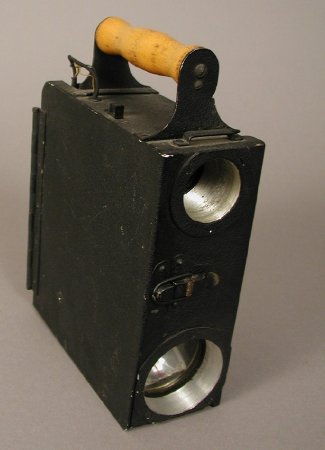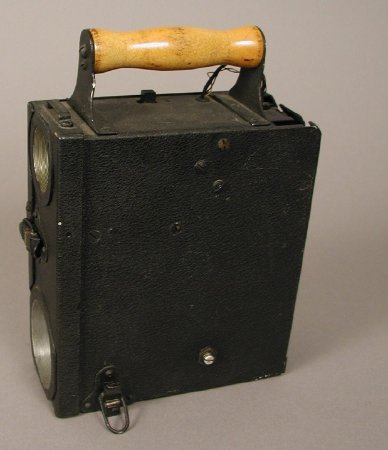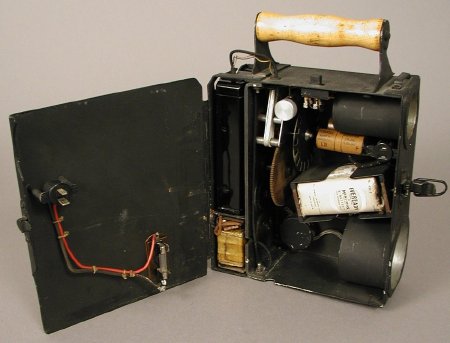Object ID:
2007.33.5
Title:
U.S. Signal Corps Sensory Aid, prototype
Description:
Machined aluminum case with a black textured enamel finish; turned wooden handle between two brackets on top; brackets for straps, two riveted to back, one riveted in front of handle; sliding toggle on/off switch on top to right (proper) of handle; two machined aluminum lens housings on front of case, stacked with smaller lens above larger; rotary adjustment screw on lower left side of case; drawbolt type latch on lower left (unknown purpose); piano hinged door on right secured by drawbolt; two battery compartments on interior, first is removable Bakelite (Cambridge Instrument Co.) case which holds one type A cylindrical battery and one type B "Minimax B Battery for hearing aids (dated Oct 1947)", second is open box with two type Bs as described above; workings inside feature small "Magnac" electric motor, and capacitor from Cornell Dubilier with patent# 1783949; aluminum case for light bulb stamped with serial# 1, which is also marked on several of the gears; fuse case mounted inside door, connected to plug which insures that device will not function with the door open.
Dimensions:
H-9 W-3.25 D-7 inches
Date:
ca. 1947
Made by:
U.S. Army Signal Corps; Cranberg, Lawrence
Provenance:
Lawrence Cranberg designed an obstacle detector at the U.S. Army Signal Corp Engineering Lab in 1943. Twenty-five experimental units were later manufactured by RCA in 1950. This appears to be one of the Signal Corps' original prototypes, produced prior to the RCA contract. Haverford College was contracted to field test the RCA version by the Veterans Administration in 1950. Haverford subcontracted the work to Biophysical Instruments, Inc., whose study led directly to the development of the G-5 Obstacle Detector and its related versions.
Cranberg's device sent out a beam of light, which when reflected off an obstacle/object, was detected by the machine. On the RCA machine, output was delivered by a vibrating plate in the handle. It is not apparent how output was delivered on this prototype.
Cranberg's device sent out a beam of light, which when reflected off an obstacle/object, was detected by the machine. On the RCA machine, output was delivered by a vibrating plate in the handle. It is not apparent how output was delivered on this prototype.
Credit Line:
Gift of Association for Education and Rehabilitation of the Blind and Visually Impaired


